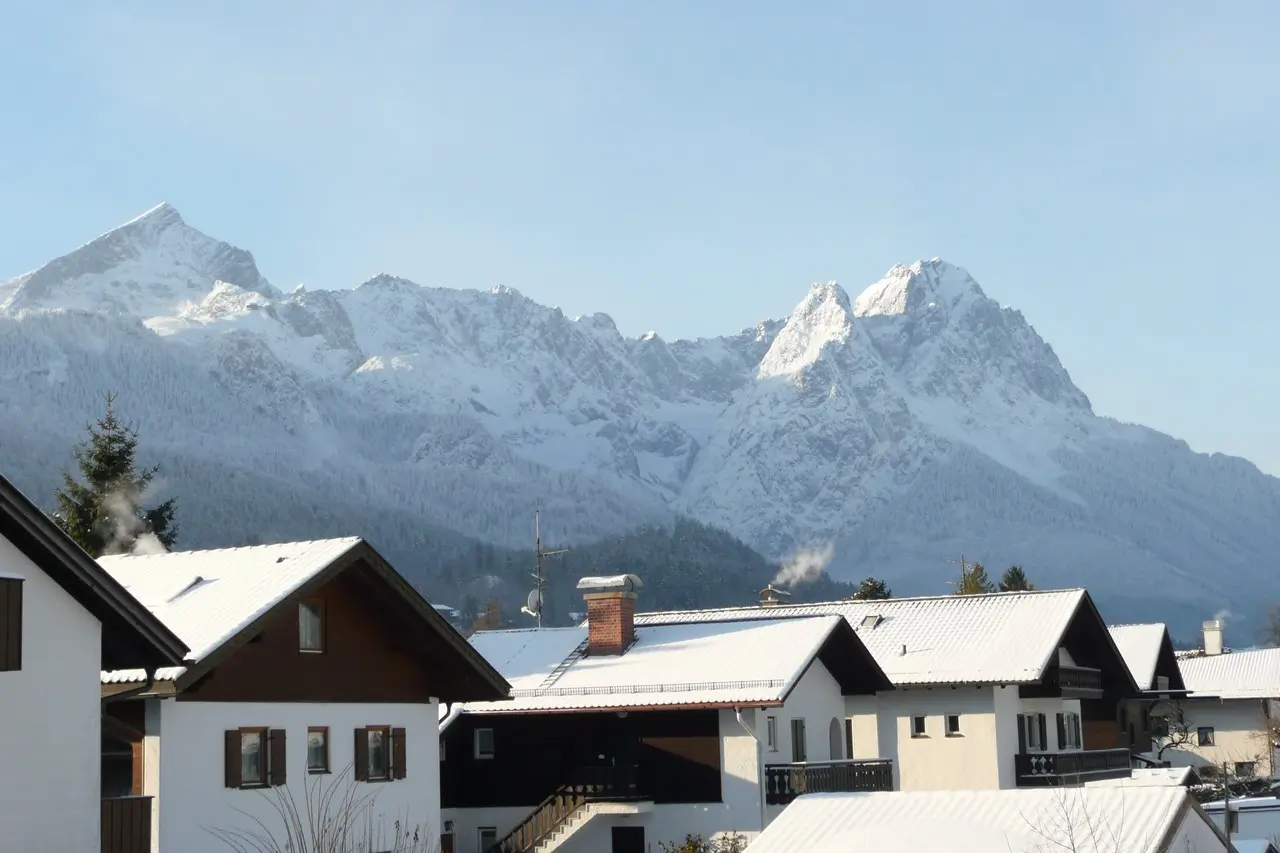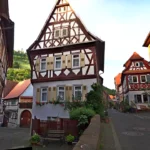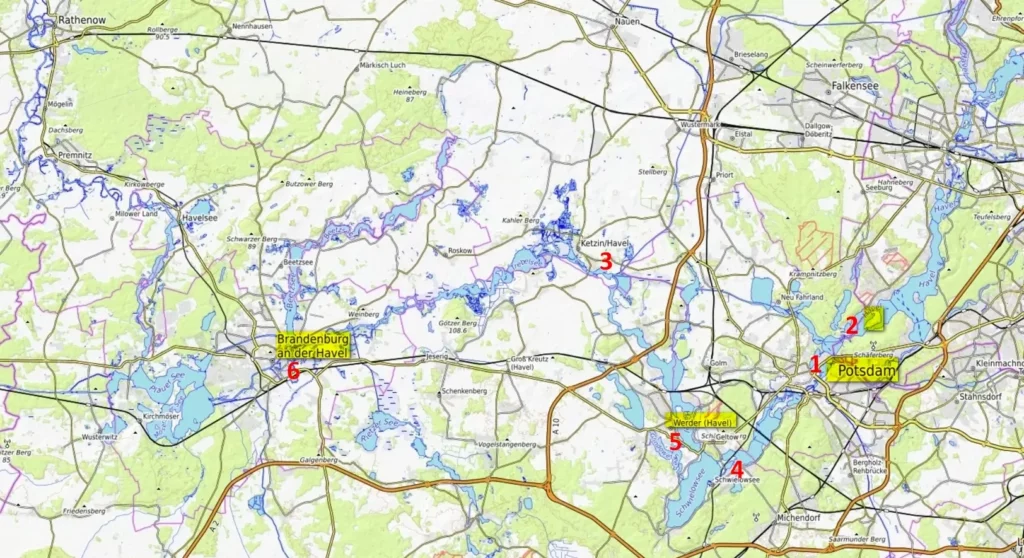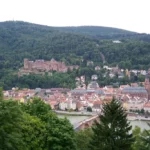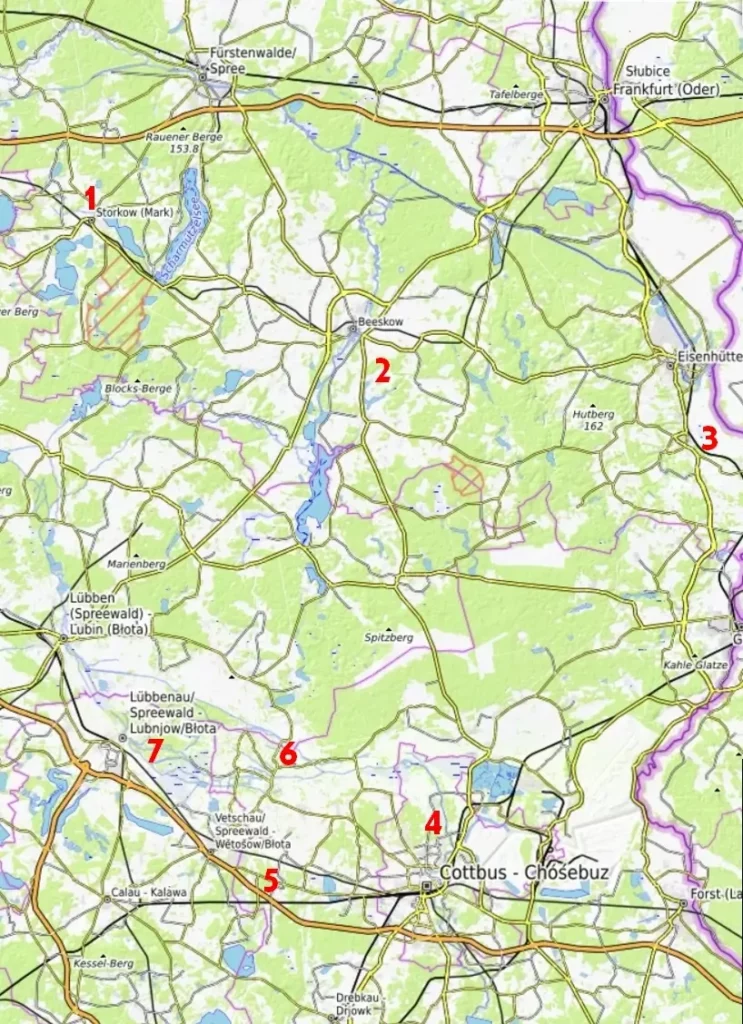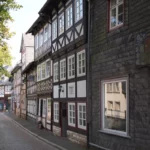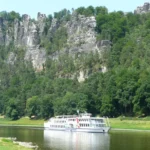Last Updated on 27/08/2024
Garmisch-Partenkirchen is known primarily for the fact that it is near the Zugspitze, the highest mountain in Germany.
Garmisch-Partenkirchen unites two settlements, respectively Garmisch and Partenkirchen. In 1936, the Olympic Games were held here, for which, under strong pressure from the authorities, the two villages were united.
Read about Zugspitze and what is nearby in the part 3. In this part about other attractions of Garmisch (city, Wank mountain)
Partnachklamm gorge in winter and summer, other possibilities in part 2
Schwangau. Füssen. Around Neuschwanstein Castle
Schwangau. 1. Neuschwanstein castle, Hohenschwangau, Alpsee
Bavaria. Allgäu. What to see map
Linderhof
From Bregenz to Innsbruck. What to visit
Zugspitze Arena Ehrwald, Lermoos, Bichlbach
From Ga-Pa (as the locals easily shorten the name of their city), you can climb not only the Zugspitze, but also to other peaks using a variety of cable cars and lifts.
Those looking to explore the region intensively should consider purchasing the ZugspitzCard.
Garmisch vs Partenkirchen
Partenkirchen is a village stretching along the main street, is a kind of sleeping area.
Garmisch, on the contrary, is a trendy resort with plenty of shops that belongs to the “must-have” of much larger cities. It seems that there are not enough of restaurants, but you only should look on the side streets in the center of Garmisch.
Partenkirchen was an important station on the north-south route as early as Roman times.
Garmisch was first mentioned at the beginning of the 9th century.
From the 13th century both villages fell into the possession of the bishops and remained there until secularization in 1802.
The historical part of Partenkirchen was badly damaged in a fire in the 19th century. Only a few houses have survived: Alte Haus (Ludwigstrasse 8), Gasthof Fraundorfer and some others.
The tourist center is located on the territory of Garmisch: in addition it has also a spa park, where concerts are regularly held, and a casino. The historic quarter of Garmisch is to the side, to the north, behind the Loisach, around Frühlingstrasse. Here is the Old Church (13th century).
Ga-Pa is still not a city, but a “trading settlement” (Markt). And although there is a shopping street with popular clothing and sports shops, they close, like in village, at 18.30.
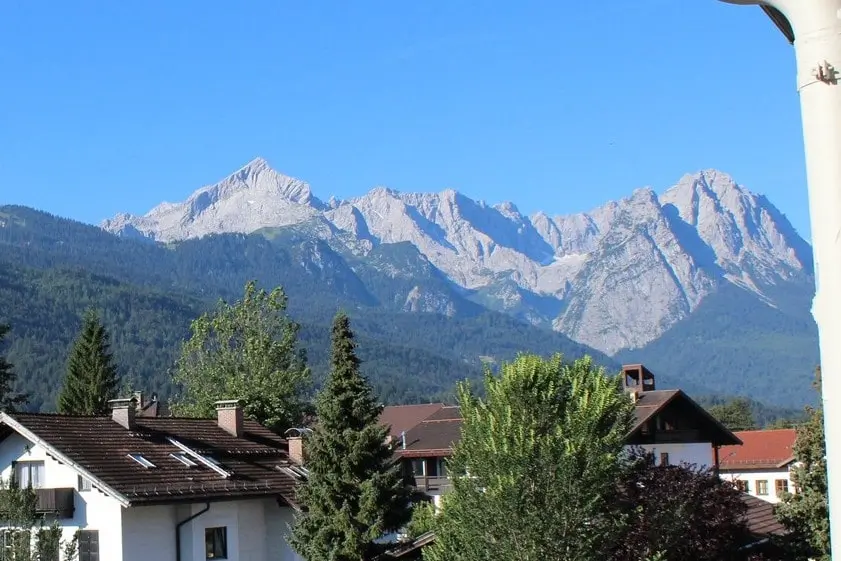
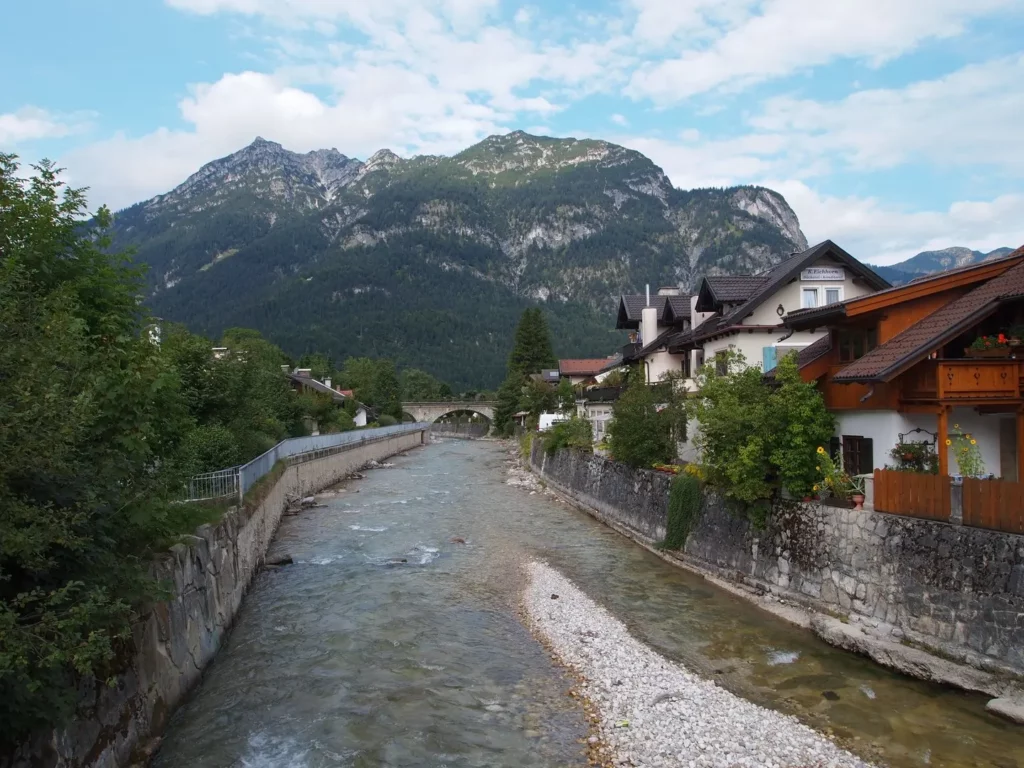
What to see in Garmisch-Partenkirchen
There are a couple of small museums in Garmisch-Partenkirchen: the Werdenfelser Heimatmuseum for the history of the region (on the Ludwigstrasse in Partenkirchen) and the Museum Aschenbrenner for porcelain, dolls and Christmas figures.
As in other alpine (and not only) villages, the main feature of the local architecture is Luftmalerei, that is, outdoor painting. Almost every house has at least something painted, and some are painted literally from head to toe.
Other entertainments include the Alpspitz Wellenbad thermal pool and the Olympic skating rink. They are located near the station. The pool can be used once for free with a city card. There is a warm pool for toddlers, a shallow pool for children, a small very warm pool, a large swimming pool where waves are released once an hour, and a jumping pool. The skating rink has public skating, but the schedule depends on the season and activities at the skating rink.
There are also natural reservoirs adapted for swimming.
- Kainzenbad is located near the springboard and ski stadium with a water temperature of 18-22 degrees.
- Strandbad Pflegersee (18-23 degrees) is located at the foot of the Kramerspitz, opposite the Burgrain suburb.
- The Strandbad Riessersee hides on a terrace above Garmisch, between the cable car on the Hausberg and the cable car on the Alpspitze.
Nearest lifts and routes
In Garmisch-Partenkirchen itself there are three cable cars that can be reached on foot or by city bus.
Hausbergbahn
Winter gondola cable car. Rises to the “home” mountain – Hausberg (1340 m). From the upper station of the cable car, a chairlift rises even higher.
This slope has good slopes for beginner skiers, and children are taught at the lower station.
This cable car does not work in summer. In winter, it is worth avoiding this mountain on weekends when “day” skiers come from Munich. On weekends, it is better to go to the neighboring mountains.
Wankbahn
Summer cable car. Rises to Mount Wank (1780 m). The cabins are smaller and older than at Hausberg. There is an intermediate station, but it may interest only hikers. In winter, the cable car is only open during the Christmas holidays.
From the Wank mountain, panoramic views open up, which only in the direction of Munich are closed by the nearby higher mountains.
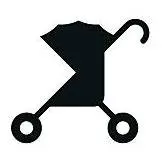
The top is partially passable, the road down is not passable
Pleasure – 4
Education – 0
Age – on the top any, road down – from 8-9 years


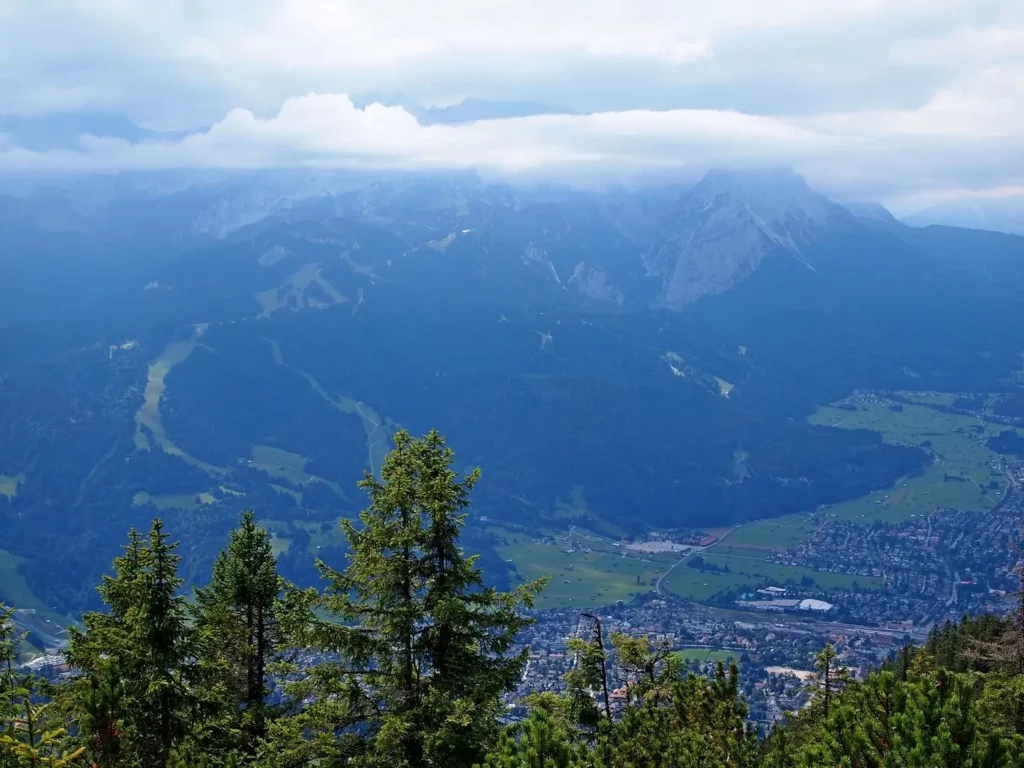
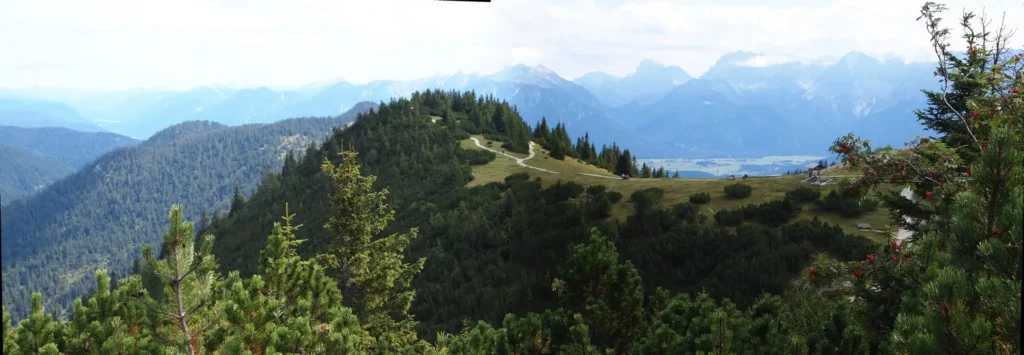
Let’s explore local attractions with a panoramic view from Mount Wank.
View to the west, southwest, towards the city. All panoramas can be enlarge.
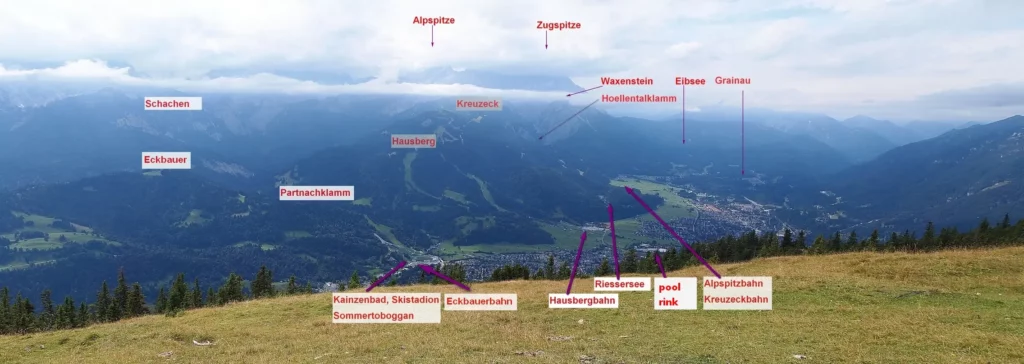
Further clockwise: west and northwest.
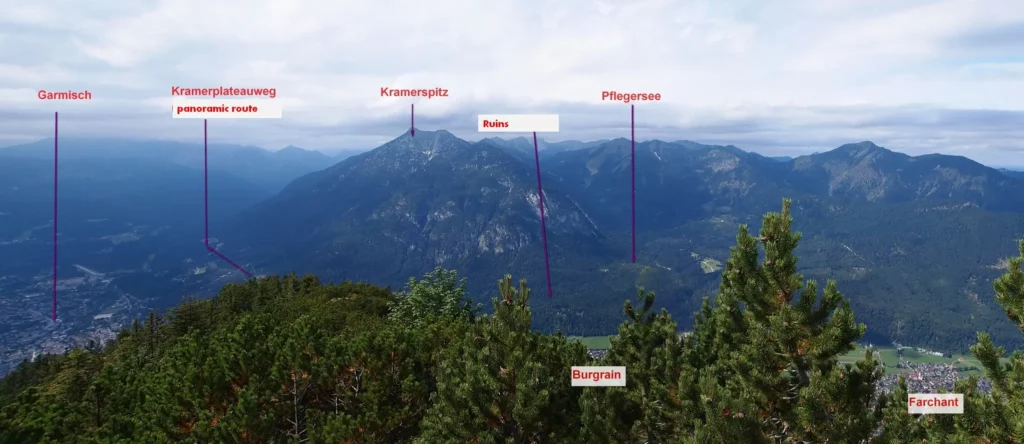

To the north-east.

Finally south.

All panoramas, as you can see, were shot from different points. From the cable car you can walk to different viewing platforms, the farthest one is about an hour and a half to and fro.
There is a rope park (from 6 years old) just above the lower station of the cable car.
Other routes from Ga-Pa
There are several more routes near the city:
1. Partnachklamm and around it (see next part)
2. Mount Kramerspitz.
3. Along Kramerspitz to the Pflegersee lake and the ruins of the Werdenfels fortress.
4. Trail to the Kuhflucht Wasserfälle cascade from Farchant village.
5. Zugspitze, Alpspitze and around.
Read more about Zugspitze, Alpspitze und Eibsee
Nearby to visit
Around Innsbruck. From Reutte to Brenner
What to do in Allgäu map
Upper Bavaria Map of attractions
1. Linderhof and Ettal Monastery
More about Linderhof on a separate page.
How to get: bus 9606 to Ettal, then bus 9622. In summer, you can take a circular route by car: one way through Ettal and the other through Lake Plansee. In winter, the valley where Linderhof is located and the road to Plansee are often heavily covered with snow and even winter tires will not be enough along the way.
2. Oberammergau. Bus 9606. In Oberammergau, in addition to numerous painted houses, there are two cable cars and a modern coaster.
3. Plansee. A very beautiful lake connected to the neighboring lake by a small canal. In summer, the highest-mountainous pleasure boats in Austria operate on the lake. How to get: train to Heiterwang, then walk one and a half kilometers.
4. Austrian Zugspitze Arena
More about Ehrwald and Lermoos, lakes.
4. Bavarian Open Air Museum – Freilichtmuseum Glentleiten. The largest museum of its kind in Bavaria. Some of the crafts are on display every day, others are scheduled. How to get: train to Murnau, then by bus towards Großweil.
5. Mittenwald – cable car Karwendel and hiking. New trail Leutascher Geisterklamm (iron bridges, fortified on the sheer wall of the gorge).
6. Walchensee – a large picturesque lake. How to get: bus 9608 (40 minutes).
Look at all sights on maps of attractions.
Garmisch-Partenkirchen – part 2
Garmisch-Partenkirchen – part 3
Sights from Austria side (map)
Linderhof
Zugspitze Arena
Do you enjoy the site without cookies? This means that I work for you at my own expense.
Perhaps you would like to support my work here.
Or change your cookie settings here. I don’t use personalized ads

